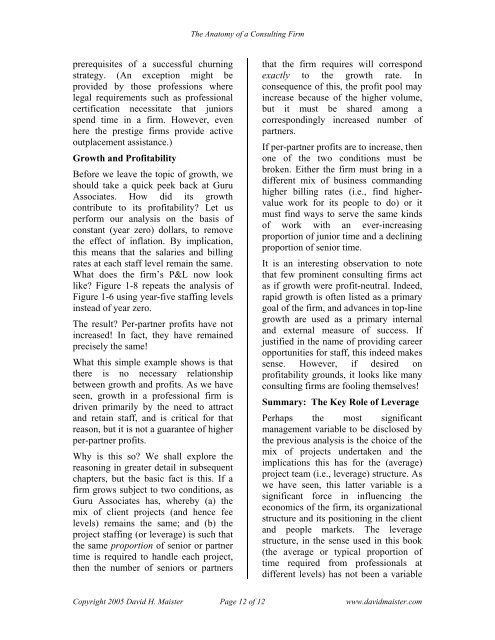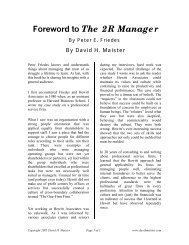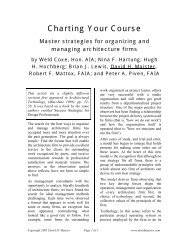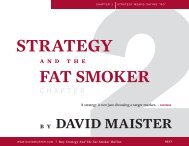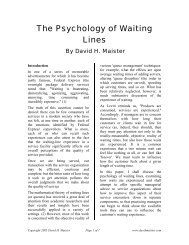pdf version - David Maister
pdf version - David Maister
pdf version - David Maister
You also want an ePaper? Increase the reach of your titles
YUMPU automatically turns print PDFs into web optimized ePapers that Google loves.
The Anatomy of a Consulting Firm<br />
prerequisites of a successful churning<br />
strategy. (An exception might be<br />
provided by those professions where<br />
legal requirements such as professional<br />
certification necessitate that juniors<br />
spend time in a firm. However, even<br />
here the prestige firms provide active<br />
outplacement assistance.)<br />
Growth and Profitability<br />
Before we leave the topic of growth, we<br />
should take a quick peek back at Guru<br />
Associates. How did its growth<br />
contribute to its profitability? Let us<br />
perform our analysis on the basis of<br />
constant (year zero) dollars, to remove<br />
the effect of inflation. By implication,<br />
this means that the salaries and billing<br />
rates at each staff level remain the same.<br />
What does the firm’s P&L now look<br />
like? Figure 1-8 repeats the analysis of<br />
Figure 1-6 using year-five staffing levels<br />
instead of year zero.<br />
The result? Per-partner profits have not<br />
increased! In fact, they have remained<br />
precisely the same!<br />
What this simple example shows is that<br />
there is no necessary relationship<br />
between growth and profits. As we have<br />
seen, growth in a professional firm is<br />
driven primarily by the need to attract<br />
and retain staff, and is critical for that<br />
reason, but it is not a guarantee of higher<br />
per-partner profits.<br />
Why is this so? We shall explore the<br />
reasoning in greater detail in subsequent<br />
chapters, but the basic fact is this. If a<br />
firm grows subject to two conditions, as<br />
Guru Associates has, whereby (a) the<br />
mix of client projects (and hence fee<br />
levels) remains the same; and (b) the<br />
project staffing (or leverage) is such that<br />
the same proportion of senior or partner<br />
time is required to handle each project,<br />
then the number of seniors or partners<br />
that the firm requires will correspond<br />
exactly to the growth rate. In<br />
consequence of this, the profit pool may<br />
increase because of the higher volume,<br />
but it must be shared among a<br />
correspondingly increased number of<br />
partners.<br />
If per-partner profits are to increase, then<br />
one of the two conditions must be<br />
broken. Either the firm must bring in a<br />
different mix of business commanding<br />
higher billing rates (i.e., find highervalue<br />
work for its people to do) or it<br />
must find ways to serve the same kinds<br />
of work with an ever-increasing<br />
proportion of junior time and a declining<br />
proportion of senior time.<br />
It is an interesting observation to note<br />
that few prominent consulting firms act<br />
as if growth were profit-neutral. Indeed,<br />
rapid growth is often listed as a primary<br />
goal of the firm, and advances in top-line<br />
growth are used as a primary internal<br />
and external measure of success. If<br />
justified in the name of providing career<br />
opportunities for staff, this indeed makes<br />
sense. However, if desired on<br />
profitability grounds, it looks like many<br />
consulting firms are fooling themselves!<br />
Summary: The Key Role of Leverage<br />
Perhaps the most significant<br />
management variable to be disclosed by<br />
the previous analysis is the choice of the<br />
mix of projects undertaken and the<br />
implications this has for the (average)<br />
project team (i.e., leverage) structure. As<br />
we have seen, this latter variable is a<br />
significant force in influencing the<br />
economics of the firm, its organizational<br />
structure and its positioning in the client<br />
and people markets. The leverage<br />
structure, in the sense used in this book<br />
(the average or typical proportion of<br />
time required from professionals at<br />
different levels) has not been a variable<br />
Copyright 2005 <strong>David</strong> H. <strong>Maister</strong> Page 12 of 12 www.davidmaister.com


